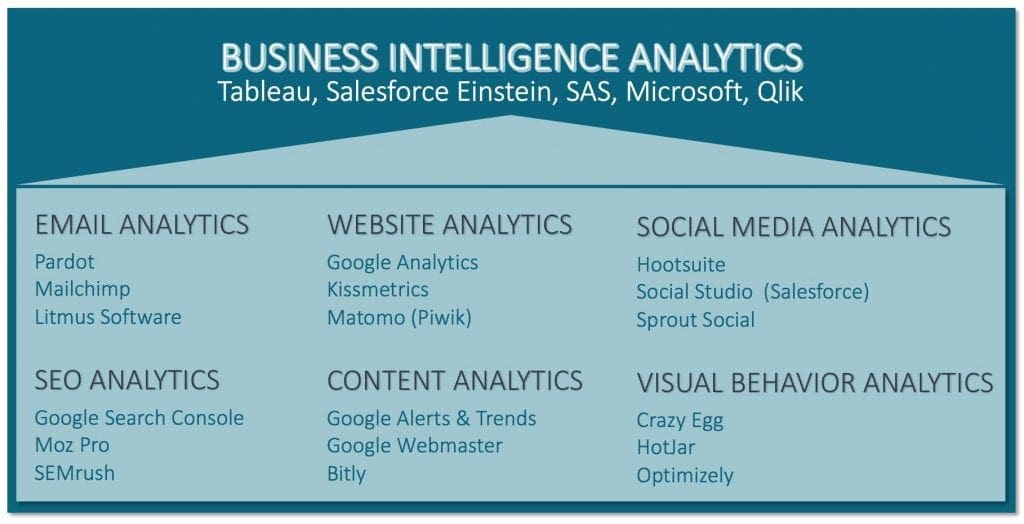Revving Up Marketing Analytics? Fractional CMOs Can Show You How!
(Written with Thomas Plocher and Will Ayd)
As Fractional Chief Marketing Officers, we’re often called on by clients who are eager to show measurable results but unsure of how to tap the full power of marketing analytics. With new platforms appearing around every turn, it can be tough to know how to get started and what to expect from your investment.
But get started you should! Without analytics to steer marketing outreach consistently in the right direction, your business risks getting left behind in today’s ever-faster digital world. From core sales and marketing automation tools to advanced analytics, modern marketing will keep you competitive and help you drive growth and profitability by identifying what’s really moving the revenue needle.
Modern Marketing Departments: From Scapegoats to Measurable Results Superstars
Only a few short years ago, as Marketri Fractional CMO Thomas Plocher explains, “marketing was considered a cost center, one that spent money on largely untrackable activities.” When revenue numbers stalled or fell, marketing departments became scapegoats, unable to point to measurable results from their efforts. Today, marketers have ready answers to the basic question that’s often asked:
How many new clients, sales qualified leads, marketing qualified leads, and cold leads have been generated through marketing outreach?”
Employing marketing analytics, marketers can now gain an extraordinary level of insight into consumer behavior. They can evaluate website performance down to the smallest detail. Which pages are holding the attention of visitors? Are pages being viewed in full? For how long? Which hyperlinks are getting clicked on? Which aren’t?
They can analyze email campaign performance, utilizing A/B tests and looking at delivery rates, open rates, and click through rates. Are email recipients being moved to click on landing pages? Which landing pages are moving visitors to download additional content? Are gated pages working as well as ungated pages?
Interested in ranking higher with Google for a particular area of company expertise? Analytics can point the way. Marketers supported by analytics can also assess social media performance. They can look at funnel velocity, compare data across verticals, and see correlations between lead scores/grades and real Salesforce leads. The list goes on and on, and the potential is almost limitless.
Once marketers know what’s working and – equally as important – what’s not, they can “double down” and optimize promising activities. No more costly wheel spinning and guesswork. Backed by analytics and able to make agile adjustments, today’s marketing departments have gone from being dismissed as cost centers to being applauded as investment centers that play a critical role in growth and profitability for companies of any size.
Before You Do Anything, Get Your Conceptual Ducks in a Row
Will Ayd is the owner of innobi, a data analytics company, and the catchy lead tagline on his website is “Data. Turned Up to 11.” (Extra points to anyone who remembers the amp in Spinal Tap!) We asked Will to suggest some first steps for those ready to introduce analytics into their marketing mixes.
As he emphasizes, a company first needs to take a long, hard look at its goals before any marketing analytics are attempted. Although questions about business goals may seem easy to answer, it’s not uncommon for owners and key personnel to struggle with responses. Going through the process of revisiting goals is a vital part of the marketing analytics process because it helps to establish the right metrics – the kind that deliver needle-moving results.
Beyond defining clear goals, Will suggests even more conceptual clarification. “For example, clients will tell me that they want to generate more leads,” he says. “But how do they define a lead? In order to count leads accurately, we have to know that company’s definition or help them hone one.” The broader point? Figure out exactly what you want to measure before you try to measure it!
Goals Outlined and Concepts Defined. Now What?
Once the conceptual work is done, companies can take their first steps into modern marketing analytics. If one isn’t already in place, Thomas suggests investing in a well-integrated sales and marketing automation platform like HubSpot, Salesforce, Oracle, or Adobe/Marketo as your analytics foundation.
Lots of growth-oriented companies have already made this leap. “We’re seeing more and more clients with Salesforce or something similar in place already,” explains Will. “That’s a great start, but you can only go so far with a tool that doesn’t have reporting capabilities.” Platforms like Salesforce are operational only, offering no way to explore your data. He continues: “You’ll be able to check off boxes for completing A, B, and C, but you won’t be able to question whether you should be doing A, B, and C in the first place. That’s where analytics come in.”
The recent purchase of business intelligence platform Tableau by Salesforce confirms Will’s thinking. If you’re using Salesforce without a reporting tool, it’s worth paying attention to this development. As Will summarizes, “With Tableau, patterns will emerge. You’ll be able to unlock larger data sets and build out reports more easily. You can bet that this pairing is about as optimal as you can get in terms of developing both your operational and reporting muscles.”
The Possibilities of Marketing Analytics
With a sales and marketing automation platform in place, you’re ready to dig deeper and gain even more insight. “No matter what platforms you adopt,” Thomas says, “the key is that you are able to consolidate and correlate data from all marketing channels into a single view, report, or dashboard.” He shares what a fully developed analytics system might look like:

Will reflects on cost: “When you factor in all the possibilities as well as the fact that hidden inefficiencies are drags on growth and profitability, analytics investments like these can pay off far sooner than you might think.” For companies that want to proceed one step at a time? “Consider adding Google Analytics to your sales and marketing platform,” Thomas advises. “That’s a great first step into analytics, one that can benefit any company with a website.”
Bring in a Fractional CMO to Get the Most from Your Marketing Analytics
A little confused by all the offerings and not sure what you need? You’re not alone. The good news is that you don’t have to become a fully-versed expert to utilize analytics successfully. Help is available, and an experienced Fractional CMO can do the heavy lifting for you.
On a macro level, a Fractional CMO can craft a comprehensive strategic marketing plan so that your analytics are not operating in a vacuum. He or she can help you decide what platforms are right for you, overseeing installation and configuration. A poorly configured technology stack is a real liability, potentially delivering inaccurate results that drive costly bad decisions. Invest in someone who can set things up right on Day One. A Fractional CMO can also work with you to establish clear data standards so that inconsistencies and redundancies don’t bubble up later and cause a ripple effect. Beyond that, a Fractional CMO can ensure that platforms are synced so that information is flowing well from one to another. Finally, when results come in, he or she can help you calibrate next steps for maximum marketing impact.
Close Business Faster with the Right Marketing Analytics in Place
Think about a sales department that no longer has to make cold calls. Imagine being able to track a prospect through the funnel, nudging them along with proven strategies and content. With the right marketing analytics in place, you will be able to close business faster. It’s really that straightforward. Ready to get started? Then contact us.
To learn more about strategic marketing plans and their execution–of which analytics are a key part–you can download our executive guide to strategic marketing plans:






